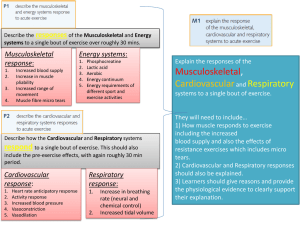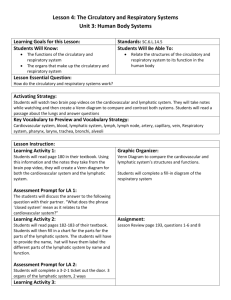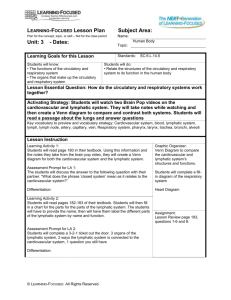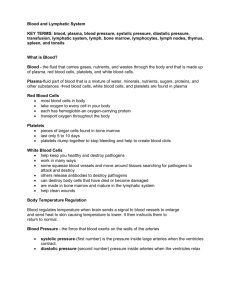Section: The Cardiovascular System
advertisement
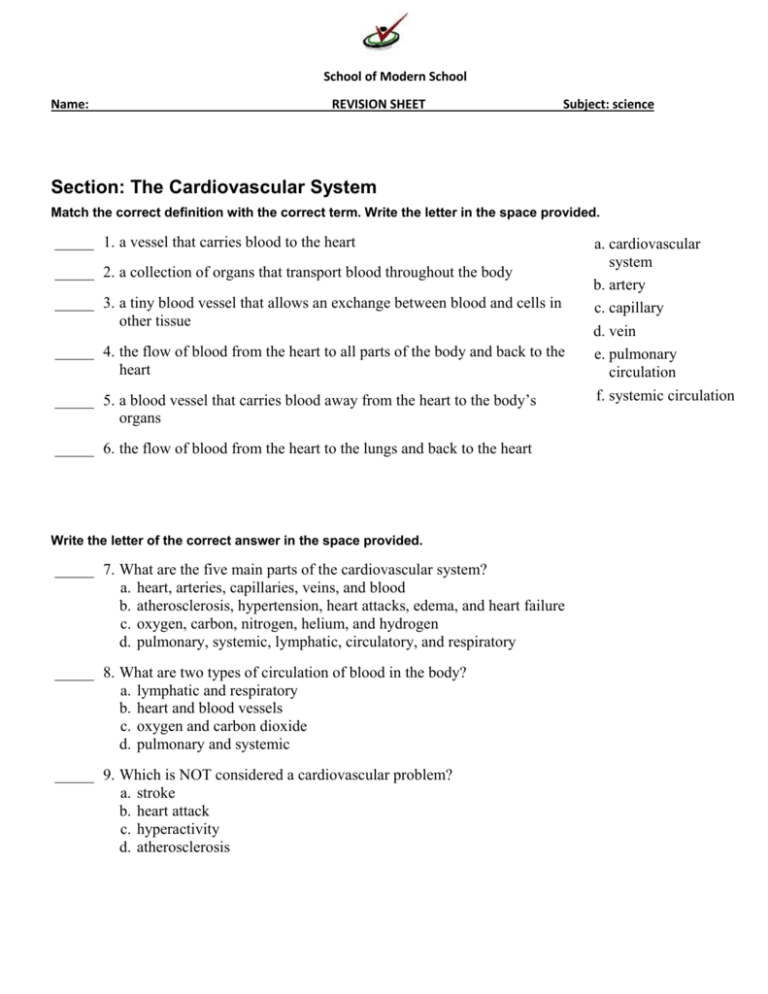
School of Modern School Name: REVISION SHEET Subject: science Section: The Cardiovascular System Match the correct definition with the correct term. Write the letter in the space provided. _____ 1. a vessel that carries blood to the heart _____ 2. a collection of organs that transport blood throughout the body _____ 3. a tiny blood vessel that allows an exchange between blood and cells in other tissue _____ 4. the flow of blood from the heart to all parts of the body and back to the heart _____ 5. a blood vessel that carries blood away from the heart to the body’s organs _____ 6. the flow of blood from the heart to the lungs and back to the heart Write the letter of the correct answer in the space provided. _____ 7. What are the five main parts of the cardiovascular system? a. heart, arteries, capillaries, veins, and blood b. atherosclerosis, hypertension, heart attacks, edema, and heart failure c. oxygen, carbon, nitrogen, helium, and hydrogen d. pulmonary, systemic, lymphatic, circulatory, and respiratory _____ 8. What are two types of circulation of blood in the body? a. lymphatic and respiratory b. heart and blood vessels c. oxygen and carbon dioxide d. pulmonary and systemic _____ 9. Which is NOT considered a cardiovascular problem? a. stroke b. heart attack c. hyperactivity d. atherosclerosis a. cardiovascular system b. artery c. capillary d. vein e. pulmonary circulation f. systemic circulation 1. artery and vein ______________________________________________________________ ______________________________________________________________ 2. systemic circulation and pulmonary circulation ______________________________________________________________ _____ 3. Which of the following is true of blood in the pulmonary veins? a. The blood is going to the body. b. The blood is oxygen poor. c. The blood is going to the lungs. d. The blood is oxygen rich. 4. What are the five parts of the cardiovascular system? Describe the functions of each part. ______________________________________________________________ ______________________________________________________________ ______________________________________________________________ ______________________________________________________________ ______________________________________________________________ 5. What is the difference between a heart attack and heart failure? ______________________________________________________________ ______________________________________________________________ ______________________________________________________________ 8. One of aspirin’s effects is that it prevents platelets from being too “sticky.” Why might doctors prescribe aspirin for patients who have had a heart attack? ______________________________________________________________ ______________________________________________________________ ______________________________________________________________ 9. Veins and arteries are everywhere in your body. When a pulse is taken, it is usually taken at an artery in the neck or wrist. Explain why. ______________________________________________________________ ______________________________________________________________ ______________________________________________________________ 10. Why is the structure of arteries different from the structure of capillaries? ______________________________________________________________ BLOOD Match the correct definition with the correct term. Write the letter in the space provided. _____ 1. the force that the blood exerts on the walls of the arteries _____ 2. the fluid that carries gases, nutrients, and wastes through the body a. blood b. blood pressure Write the letter of the correct answer in the space provided. _____ 3. The main components of blood are a. systolic and diastolic. b. antibodies, antigens, and pathogens. c. plasma, RBCs, WBCs, and platelets. d. A, B, AB, and O. _____ 4. The main functions of blood are to a. digest food and break it down to be used as energy. b. carry oxygen, nutrients, and wastes; fight disease; and regulate temperature. c. carry messages through all the body to direct body movement. d. carry messages to parts of cells to tell them how to develop. _____ 5. Which of the following words describe blood pressure inside large artery walls when heart ventricles contract and relax? a. systolic and diastolic b. antibody and antigen c. RBC and WBC d. plasma and platelet _____ 6. Which of the following are blood types? a. systolic and diastolic b. antibodies, antigens, and pathogens c. plasma, RBCs, WBCs, and platelets d. A, B, AB, and O 1.Use each of the following terms in a separate sentence: blood and blood pressure. ______________________________________________________________ ______________________________________________________________ _____ 2. A person with type B blood can donate blood to people with which type(s) of blood? a. B, AB b. A, AB c. AB only d. All types 3. List the four main components of blood and tell what each component does. ______________________________________________________________ ______________________________________________________________ ______________________________________________________________ ______________________________________________________________ 4. Why is it important for a doctor to know a patient’s blood type? ______________________________________________________________ ______________________________________________________________ 5. How does the body use blood and blood vessels to help maintain proper body temperature? ______________________________________________________________ ______________________________________________________________ ______________________________________________________________ ______________________________________________________________ ______________________________________________________________ ______________________________________________________________ 6. Some blood conditions and diseases affect the ability of red blood cells to deliver oxygen to cells of the body. Predict what might happen to a person with a disease of that type. ______________________________________________________________ ______________________________________________________________ ______________________________________________________________ ______________________________________________________________ Section: The Respiratory System Match the correct definition with the correct term. Write the letter in the space provided. _____ 1. the exchange of oxygen and carbon dioxide between living cells and their environment _____ 2. a collection of organs whose primary function is to take in oxygen and expel carbon dioxide _____ 3. the passage from the mouth to the larynx and esophagus _____ 4. the area of the throat that contains the vocal cords and produces vocal sounds a. alveoli b. trachea c. pharynx d. bronchi e. respiratory system f. larynx g. respiration _____ 5. the tube connecting larynx and lungs _____ 6. two tubes connecting lungs and trachea _____ 7. tiny air sacs of the lungs where oxygen and carbon dioxide are exchanged Write the letter of the correct answer in the space provided. _____ 8. What are you doing when your diaphragm and rib muscles contract, and air enters the space created inside the your chest cavity? a. coughing c. inhaling b. eating d. exhaling _____ 9. What systems are working together during the process of respiration? a. respiratory and lymphatic systems b. respiratory and cardiovascular systems c. lymphatic and cardiovascular systems d. respiratory, lymphatic, and cardiovascular systems _____ 10. Which of the following is NOT a respiratory disease? a. asthma c. SARS b. emphysema d. hypertension For each pair of terms, explain how the meanings of the terms differ. 1. Pharynx and larynx ______________________________________________________________ ______________________________________________________________ _____ 2. Which of the following are respiratory disorders? a. SARS, alveoli, and asthma b. alveoli, emphysema, and SARS c. larynx, asthma, and SARS d. SARS, emphysema, and asthma 3. Explain how breathing happens. ______________________________________________________________ ______________________________________________________________ 4. Describe how your cardiovascular and respiratory systems work together. ______________________________________________________________ ______________________________________________________________ 7. If a respiratory disorder causes lungs to fill with fluid, how might this affect a person’s health? ______________________________________________________________ ______________________________________________________________ ______________________________________________________________ ______________________________________________________________ ______________________________________________________________ ______________________________________________________________
